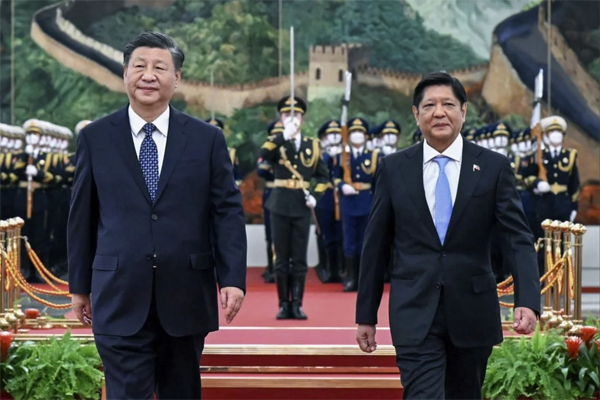Wang Huiyao: Beijing’s readiness to woo Southeast Asia with trade deals
SCMP | January 19 , 2023From SCMP, 2023-1-19
■ Despite tensions over the South China Sea, Marcos’ recent state visit shows Beijing’s readiness to woo Southeast Asia with trade deals.
■ The meeting provides a model for strengthening ties and resolving disputes with other Asean members.
 Chinese President Xi Jinping (left) and visiting Philippine President Ferdinand Marcos Jnr arrive at the Great Hall of the People in Beijing on January 4. Photo: Xinhua via AP
Chinese President Xi Jinping (left) and visiting Philippine President Ferdinand Marcos Jnr arrive at the Great Hall of the People in Beijing on January 4. Photo: Xinhua via AP
By Wang Huiyao | Founder of the Center for China and Globalization(CCG)
Recent years have seen ups and downs in China’s relations with Southeast Asia. Economic ties continue to grow but there have also been periodic frictions due to territorial disputes in the South China Sea, Covid-19 and rising strategic competition between Beijing and Washington.
This year presents a chance for Beijing to put relations with the Association of Southeast Asian Nations (Asean) on a more steady footing. China is eager to shore up ties with its Asean neighbours to prevent them being drawn too far into Washington’s orbit, while the country’s reopening paves the way to revive exchanges with the region.
Meanwhile, Asean members are prioritising growth and jobs as they face stiff economic challenges in the wake of the pandemic, increasing incentives to resolve differences and work closer with China.
The recent state visit to Beijing by Philippine President Ferdinand Marcos Jnr is the latest sign of the positive momentum in China-Asean relations. Marcos left Beijing with an impressive haul of deliverables, including US$22.8 billion in investment pledges, an agreement to allow Philippine fishermen to resume operations at their historic fishing grounds, and an offer by President Xi Jinping to reopen talks on joint oil and gas exploration.
Both sides have good reasons to pursue energy cooperation in the South China Sea and find ways to overcome the constitutional and sovereignty constraints that led to the breakdown of negotiations last year. Most importantly, working together to develop energy resources will help avoid conflict over disputed waters.
The Philippines is keen to tap new sources of fossil fuels; its reliance on energy imports makes it highly exposed to rising oil prices, while its main domestic gas supply, the Malampaya gas field, is nearing depletion.
For China, successful cooperation with the Philippines on developing energy in the South China Sea would not only help secure new sources of energy amid ongoing geopolitical uncertainty, but also provide a model for solving other disputes in the region such as with Brunei, Malaysia and Vietnam.
Marcos’ visit comes after a marked uptick of diplomatic engagement between China and Asean since the 20th party congress. At the end of October, Nguyen Phu Trong, General Secretary of the Communist Party of Vietnam, became the first foreign leader to visit China after the party congress, making his first overseas trip since suffering a stroke in 2019. Xi and Trong vowed to upgrade their “special bond” and signed 13 major agreements covering key aspects of bilateral relations.
A month later, Laos President Thongloun Sisoulith also made a state visit to China. Both sides vowed to increase cooperation, including on further boosting connectivity between the belt and road and landlocked Laos, around a year after the China-Laos railway opened.
Away from Beijing, November saw a flurry of meetings between Chinese and Asean leaders at multilateral summits in Asia. Premier Li Keqiang met leaders of the 10-nation bloc at the Asean summit in Phnom Penh and between the G20 in Bali and Apec in Bangkok, Xi met the leaders of Indonesia, the Philippines, Singapore and Thailand.
Economic cooperation is the core of China’s appeal to Southeast Asian countries and an advantage over the US in efforts to woo the region. Asean has risen to become China’s top trading partner since 2020, with two-way trade reaching US$878 billion in 2021.
The Regional Comprehensive Economic Partnership (RCEP) trade deal, which entered into force at the start of 2022, will help to further integrate supply chains between China and Southeast Asia. In November, negotiations began to upgrade the China-Asean free-trade zone, bringing the prospect of further trade liberalisation.
Looking to the rest of this year, China’s reopening will support efforts to improve relations with Asean. Entrepreneurs and officials will again be able to travel easily between the two regions, boosting trade, investment and diplomatic initiatives such as negotiations on a code of conduct for the South China Sea.
Asean countries are well placed to benefit from the rebound of Chinese tourism as pent-up demand is unleashed. Goldman Sachs estimates that increased trade and tourism from China’s reopening may lift the GDP of Thailand, Singapore and Malaysia by 2.9 per cent, 1.2 per cent and 0.7 per cent respectively.
Marcos’ visit to China shows there is the political will in Beijing and Asean capitals to settle disputes in the South China Sea and deepen economic cooperation. Joint oil and gas development could be an effective vehicle to achieve this, especially amid fluctuating energy prices and economic uncertainty. China would do well to seize this opportunity and explore similar initiatives with other Asean members.
From SCMP, 2023-1-19
Recommended Articles
-

Wang Huiyao: China and Latin America: Partners in a shared new era
-
Wang Huiyao: Only a multipolar coalition can secure Ukraine peace
-
Wang Huiyao: How to Fix the Security Council
-
Wang Huiyao: Critics are missing the big picture on China’s economic transition
-
Wang Huiyao: China-led SCO is a critical salve for the ailments of the global order